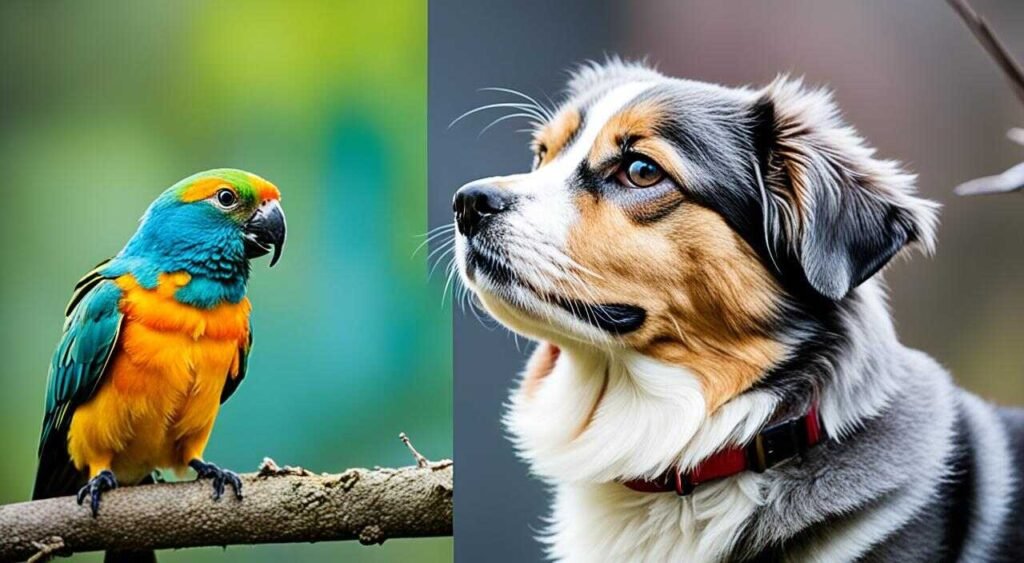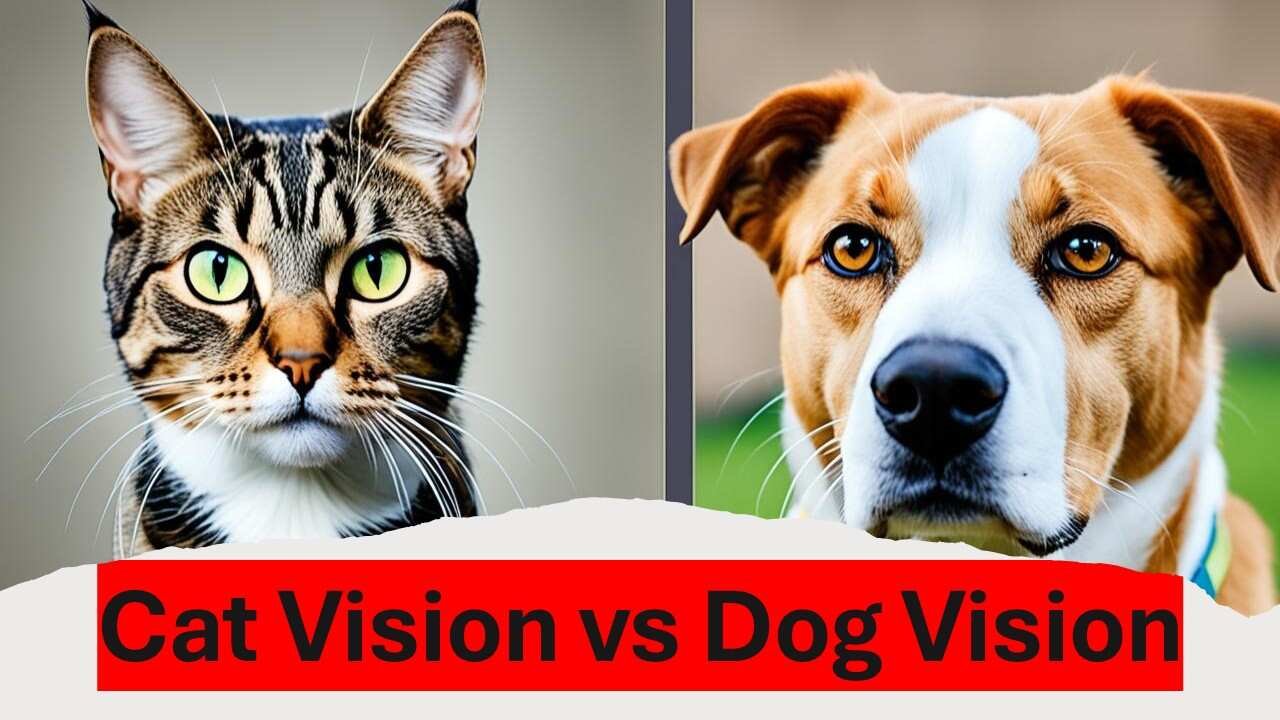Cats and dogs see the world very differently. Exploring these differences helps us understand them better.
It shows how they interact with what’s around them and with people.
Key Takeaways:
- Cats and dogs have different visual capabilities
- Cats have a wider field of vision than humans and excellent low-light vision
- Dogs have a wider field of vision than cats and rely more on motion detection
- Both cats and dogs have adaptations in their eyes to enhance night vision
- Understanding these differences can help pet owners better understand and interact with their furry friends
Key Takeaways:
- Cats have a wider field of vision than humans and excellent low-light vision
- Dogs have a wider field of vision than cats and rely more on motion detection
- Both cats and dogs have adaptations in their eyes to enhance night vision
Cat Vision
Cats see the world differently from dogs and humans. They have unique traits for seeing things. Let’s explore how cats see the world around them.
Field of Vision
Cats can see up to 200 degrees. This wide view helps them find prey easily. In contrast, humans see about 180 degrees.
Low-Light and Near Vision
Cats are amazing at seeing in the dark. They have larger pupils and sensitive retinas. This helps them hunt well at dawn and dusk. Also, their near-vision is sharp, making it easy to navigate close by.
The Tapetum
Cats have a layer behind their eyes that reflects light. This layer is the tapetum. It improves their night vision, acting like a flashlight. It helps them catch prey at night.
Color Vision
Cats see more colors than dogs but less than humans. They have trouble with some hues like pink and red. Despite this, they enjoy the colors around them.
Nearsightedness and Compensatory Senses
Cats don’t see well far off. Yet, they make up for this with sharp senses of hearing and smell. They can find things even when they can’t see them clearly.
In brief, cats’ vision is amazing and full of surprises. Their broad field of view, night vision, near vision, tapetum, and ways to cope with being nearsighted, make for an incredible view of their world.
Dog Vision
Dogs see the world differently than we do. They aren’t totally colorblind, though. They see colors in a limited way, like someone with red-green color blindness. Even so, they can tell different shades apart. But, they don’t see the fine details like we can.
Dogs are great at spotting moving things. They see motion well, which helps them chase toys or catch prey. Unlike us, they can see things moving all around them. This gives them a big advantage outdoors.
Dogs have trouble focusing on things close-up, within a foot away. Their eyes are really meant for seeing things far off or in the middle distance. This is great for spotting prey not too close by.
They have something in common with cats, too. There’s a special layer in their eyes that helps them see at night. It makes bad lighting no problem for them. This is why dogs are great at hunting in low light times.
“Dogs have an incredibly wide field of vision, enabling them to detect movements from various angles.”
Besides, they are really good at picking up hints from what we show them. They can understand when we use hand signs far away. This makes them very trainable and great at learning tricks from a distance.
Vision Comparison
Cats and dogs see and respond very differently. Cats can see better in the dark and in color. Dogs see great all around and understand what we show them. They both have a way to see better in the dark, which is interesting.
Knowing this, we can make our pets’ lives better. We just have to set things up in a way that makes sense to them. This way, we get closer to our pets.
| Cat Vision | Dog Vision | |
|---|---|---|
| Color Vision | Better color vision | Limited color vision, similar to red-green color blindness |
| Field of Vision | Approximately 200 degrees | Approximately 240 degrees |
| Visual Acuity | Nearsighted, relies on other senses for distant objects | Difficulty focusing on objects closer than a foot |
| Night Vision | Enhanced by tapetum | Enhanced by tapetum |
| Response to Visual Cues | Less responsive | Highly responsive |
Knowing how they see helps us connect better with our pets. We can tweak our homes and the way we interact to match their view. This makes for stronger relationships with our pets.
Comparing Cat and Dog Vision
Looking at cat and dog vision lets us peek into how they see the world. They see some things alike, but there are key differences.
Cat Vision
Cats see the world in their own way. They have a wide view, about 200 degrees, so they see a lot at once. This helps them find food and watch for danger. Cats are also good at seeing in low light, making them night vision experts thanks to their tapetum. This is an extra layer in their eyes that boosts their vision in the dark.
“Cats rely more on detecting motion, while dogs rely on their ability to perceive distance and depth.”
Cats see more colors than dogs. But they can’t see all shades, like pink and red. They are a bit nearsighted, making it hard to see far away. Yet, they use their keen sense of hearing and smell to make up for this.
Dog Vision
Dogs are also unique in how they see. Their view is about 240 degrees wide, which is wider than a cat’s. This wide view lets them notice moving things easily. Dogs are also great at figuring out how far away things are. They use this skill for hunting and playing fetch.
“Both cats and dogs have adaptations in their eyes to enhance their night vision.”
Dogs see fewer colors but can notice quick movements well. Their color vision is like seeing the world in shades of red and green. They pay a lot of attention to what they see. This is why they are big on watching our hands and how we move.
Visual Contrasts
Comparing cat and dog vision shows big differences. Cats are made for dim light and see more colors. Dogs have a wider view and are quick to spot things moving. Cats focus on noticing changes in their environment. Meanwhile, dogs pay attention to how far away things are. But, both have eyes that help them see better at night.
| Cat Vision | Dog Vision | |
|---|---|---|
| Field of Vision | Approximately 200 degrees | Approximately 240 degrees |
| Low-Light Vision | Exceptional | Good |
| Color Vision | Better than dogs | Limited, similar to red-green color blindness |
| Focusing Ability | Nearsighted | Difficulty focusing on close objects |
| Visual Cue Perception | Reliant on detecting motion | Responsive to motion and visual cues |
Examining how cats and dogs see helps us meet their needs better. By adjusting how we interact and the spaces we share, we build stronger connections with our pets.
The Importance of Human Vision

Human vision is a key sense that helps us every day. Our eyes let us see the world and everything in it. They give us ways to experience life that are unique to us. We might be amazed by how animals see, but don’t forget how amazing human sight is too.
We see in many colors and small details. This helps us do everything from reading to driving safely. It guides our idea of what’s beautiful and lets us enjoy art. Our eyes also help us connect with others through silent messages.
Taking care of our eyes is very important. There are steps we can take to keep them healthy. This includes eating well and having regular eye checks.
- Eat a healthy diet: Eating fruits and veggies can keep our eyes healthy. Foods like spinach and carrots are great choices for our vision.
- Schedule regular eye exams: Seeing an eye doctor often is good for our eyes. They can spot any issues early and help us keep our eyes in good shape.
- Protect your eyes: Sunglasses that block UV rays are a must. They help prevent eye diseases. It’s also smart to wear eye protection when doing things that could hurt your eyes.
If we focus on preventing eye problems, we’re likely to have better vision as we get older. Preventing issues is better than fixing them later on.
Our sight is a valuable gift. By looking after our eyes, we can continue to explore the world and enjoy its beauty.
Reference:
Mayo Clinic. Eye health: What You Can Do to Keep Your Vision Sharp. Retrieved from https://www.mayoclinic.org/…
| Comparison | Cat Vision | Dog Vision |
|---|---|---|
| Field of Vision | Approximately 200 degrees | Approximately 240 degrees |
| Low-light Vision | Excellent | Enhanced by a tapetum |
| Color Vision | Better than dogs | Limited, similar to red-green color blindness |
| Near-sightedness | Present | Difficulty focusing on objects closer than a foot |
| Dependence on Motion Detection | High | High |
| Adaptations for Night Vision | Tapetum reflects light back into the eyes | Tapetum enhances night vision |
Understanding Animal Vision
Animals like cats and dogs see the world very differently than we do. They have unique eyesight that helps them survive and thrive. Knowing how they see can help us take better care of our pets.
Cats and dogs see the world in ways that are perfect for hunting and staying safe. Their eyes have special features that enhance their abilities. This lets them see their environment clearly, find food, and understand the space around them better.
Cats and dogs are amazing at seeing in the dark. They can spot things even when it’s not very bright. This is because their eyes are good at catching the little light there is. Also, a special layer behind their eyes helps them see even better at night. They can see things we can’t when the sun goes down.
Both animals see movement in their own unique ways too. Cats are great at seeing things move up close. Their sharp eyesight helps them catch prey. Dogs, however, are experts at tracking motion from far away. This is key for their hunting skills.
Cats can see more of the area in front of them compared to us. They can watch for any prey that might be nearby, mostly up to 200 degrees around them. Dogs have an even bigger view, about 240 degrees. This wider vision helps them notice any movement or changes around them very quickly.
Feline vs Canine Eyesight Characteristics:
| Cats | Dogs |
|---|---|
| Wide field of vision (approximately 200 degrees) | Wider field of vision (approximately 240 degrees) |
| Excellent low-light vision | Superior night vision |
| Nearsighted, relying on other senses for distant objects | Difficulty focusing on objects closer than a foot |
| Better color vision | Limited color vision |
| Special tapetum for enhanced night vision | Special tapetum for enhanced night vision |
Knowing these differences lets us make their lives better. We can create activities that match how they see the world. This can make them happier and healthier.
Learning about our pets’ vision helps us bond with them. We can use what we know about their eyesight to communicate better or make their surroundings more comfortable. This strengthens the friendship we share with them.
Conclusion
Cats and dogs see the world in different ways. Cats can see well in dim light and they see colors. This helps them hunt at dawn and dusk. Dogs, on the other hand, see a lot of the world at once. They spot movement easily and judge distance. This makes them great at watching things and knowing how far away they are.
Knowing these differences helps us take better care of our pets. We can make spaces that fit what they see. This makes them feel at home and makes our bond stronger. For cats, it means making sure places are not too dark. For dogs, it could be about having lots of things to look at.
We should also adjust how we play and spend time with our pets. This understanding can make our homes happier places for everyone. We’ll learn to cherish the unique ways they see and interact with the world.
FAQ
How does cat vision differ from dog vision?
Cats have a wider field of vision. They excel in seeing in low-light. They see near objects well too. Cats grasp colors better but are nearsighted.
Are dogs completely colorblind?
No, dogs can see some colors. Their color vision is like people with red-green color blindness.
Do cats have better night vision than dogs?
Yes, cats can see very well in the dark. This is because of a special part in their eyes called the tapetum.
What is the field of vision for cats and dogs?
Cats can see up to about 200 degrees around them. Dogs see even more, up to about 240 degrees.
What visual cues are dogs more responsive to?
Dogs notice visual cues and movement well. This makes them good at understanding hand signals from afar.
How do cats and dogs perceive their surroundings differently?
Cats focus on spotting things that move. Dogs are good at telling how far things are and their shape.
What can understanding animal vision help us with?
It lets pet owners know how to make pets’ space better. It also helps in communicating with pets in ways they understand.
Why is understanding pet vision important?
It helps us take better care of our pets. Understanding their world improves our connection with them.









Leave a Reply